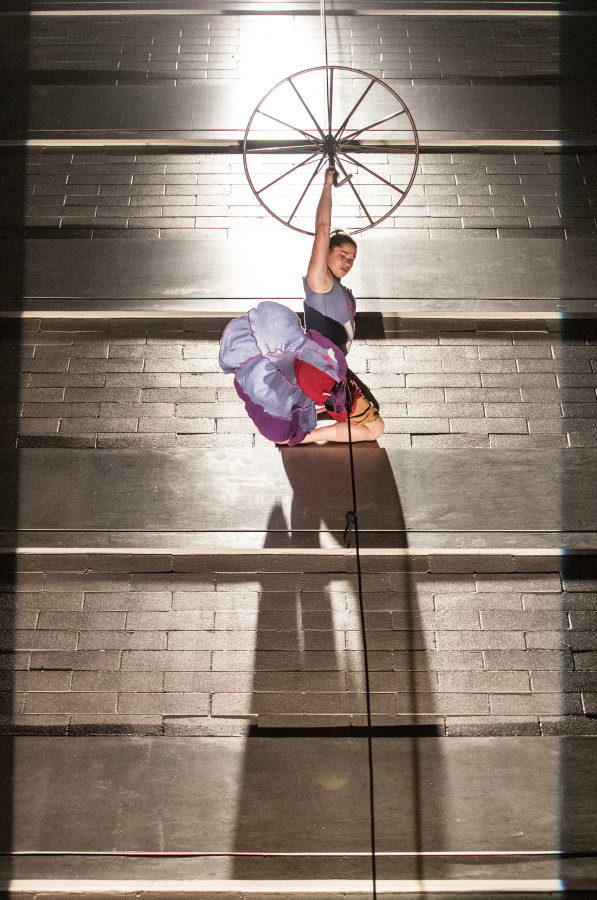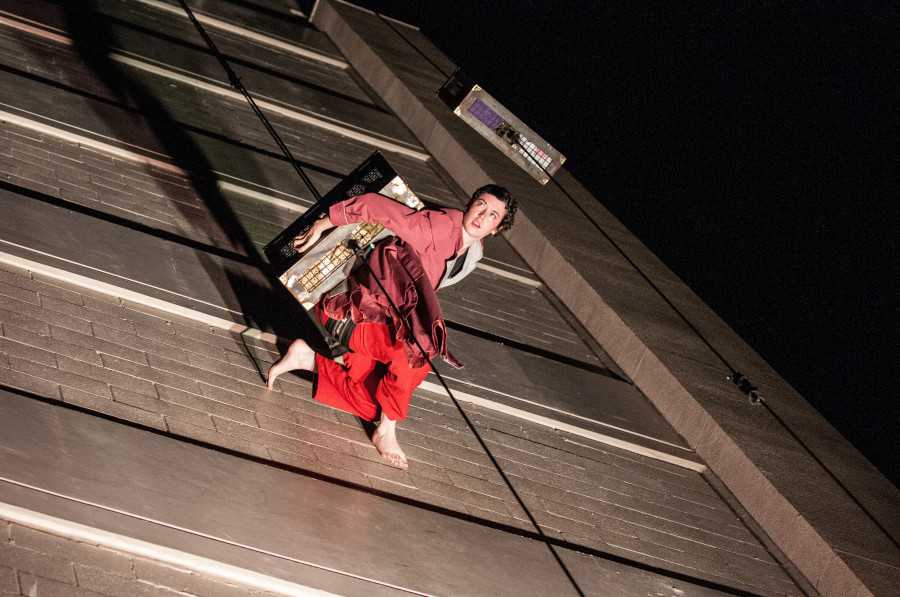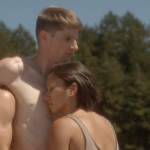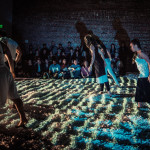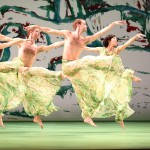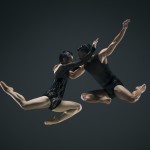
Esther Wroebel, Becca Dean and MaryStarr Hope in Jo Kreiter’s Multiple Mary and Invisible Jane at 333 Golden Gate Ave, UC Hastings College of the Law. (Photo: Austin Forbord)
As Jo Kreiter’s astonishing aerial dancers came rappelling down the side of an 80-foot concrete and brick wall at 333 Golden Gate Avenue, to an inventive score that integrates fragments of stories told by homeless women with the sounds of industrial machinery, electronic music, and the voices of a spooky choir, a disgruntled resident of a neighboring building leaned out of his window and yelled “Turn it down!” – reminding us of the perils of performing in public spaces. The music was not exactly soothing, but it was only 9:15 on a Friday night of a glorious Indian summer in San Francisco: surely the residents of this district that abuts the grim Tenderloin, and the posher environs of the Asian Art Museum, are used to the occasional racket?
The hundred-plus attendees gathered on an adjacent basketball court – plus dozens of smartphone-wielding passersby who stopped to gawk and capture snippets on video – ignored the uncivil outburst and craned their necks for the 35-minute duration of this breathtaking piece of whimsy, intended to call attention to the plight of elderly homeless women in San Francisco. (Niagara Falling, an earlier work by Kreiter highlighting the theme of urban decay and performed in a similarly sketchy neighborhood, received an Isadora Duncan award for choreography and company performance.)
The piece opened with Alayna Stroud, MaryStarr Hope and Erin Mei-Ling Stuart at the pinnacle of the building, climbing down three metal ladders onto small platforms resembling tall-backed chairs. At that height, lit mainly by several harsh overhead spots that cast eerie shadows, the dancers appear so small that you can’t make out details or facial expressions, but still close enough to see the taut muscles in their legs and arms, their hair and the layered skirts of their long tunics floating or whipping in the fickle wind.
“You couldn’t lie down, you had to sit up,” a woman’s voice explains, over and over again, like an incantation – explaining the “rules” of sleeping in a bus station. “It’s not comfortable… Your feet begin to swell.” The narrator’s voice is increasingly drowned out by the sounds of ominous creaking and metal doors slamming, while the dancers flop exhaustedly like rag dolls, then fling themselves wildly off and under the chairs, as if desperately trying to find a more comfortable position. Transposing the discomfort and the stress of sleeping rough to the challenge of dangling from the end of a rope 80 feet from the ground, with no safety net below.
The weather gods conspired with set designer Josh St. John, lighting designer Matthew Antaky and costumer Miranda Caroline to deliver a sensational and chilling spectacle, particularly in the penultimate Umbrella segment – inspired, says Kreiter, by the image of a multitude of Mary Poppinses floating down from the sky during the opening ceremony of the London Olympics. Esther Wroebel, Becca Dean and MaryStarr Hope wrestle with three deconstructed umbrella frames, pushing off the wall and flying at speeds that Mary Poppins would hardly have considered decorous. They roll the umbrella rims like wheels against the wall, nestle inside or on top of the frames as they spin, and grip the umbrella shafts between their toes as they hang upside down. Their virtuosic unison and counterpoint flying and spinning, catching and releasing of the umbrellas – a feat of timing, precision and fearlessness – is the high point of the evening, when anxiety and tension dissolve into sheer joy and freedom.
The soundscape by Pamela Z is similarly at its most inspired in this segment, an unearthly mix of cellos, a celestial choir, and a buzz and crackle like that of sparks shooting off a Tesla Coil.
Somewhat less imaginative from a choreographic perspective were the two intervening solos, though coupled with the score they drove home their blistering messages. In the first, Becca Dean climbs up the side of the building, laboriously tussling with metal cases of “stuff” that glide up and down the wall on ropes and pulleys. Voices, accompanied by a thumping bassline, sing lists of what these homeless women consider their essentials (“a change of clothes, a toothbrush…”) and remind us “you gotta watch your belongings real carefully.” In an absurd and poignant moment, the cases drift away from Dean and, 50 feet up, she peers frantically around the corner of the building.
The faces of the homeless are changing, at least in the developed world: homelessness is increasingly viewed as a succession of repeated uprootings – “the end of the line in a series of personal disasters,” says Dublin social researcher Brian Harvey. The oral histories gathered by journalist Rose Aguilar for this collaboration chronicle individual uprootings that may resonate with many in the audience. As the piece winds to a close, the women’s voices introduce themselves by first name and age. “I was evicted by Wells Fargo,” we learn of one of the six women interviewed by Aguilar, while Laura Ellis mounts a chair 80 feet in the air, visibly distraught and indignant, shaking her fists at us, her upper body convulsing. The three Umbrella dancers maintain absolute stillness, their faces to the wall as they assume a defensive crouch, as if fearful of being noticed.
There were no curtain calls. Five of the six dancers lowered themselves part way down the side of the building and, still tethered to the wall, stretched their arms out to the stunned crowd. Laura Ellis proudly continued to stake out her bus station chair.
As we trooped off the basketball court and back onto the street, volunteers held out buckets labeled “Donations.” At which prompting, Ballet to the People marched across the street to a shiny Wells Fargo ATM and withdrew a modest sum, thinking that perhaps an apt gesture for the occasion.
– This review of Multiple Mary and Invisible Jane also appeared in the Huffington Post. –


